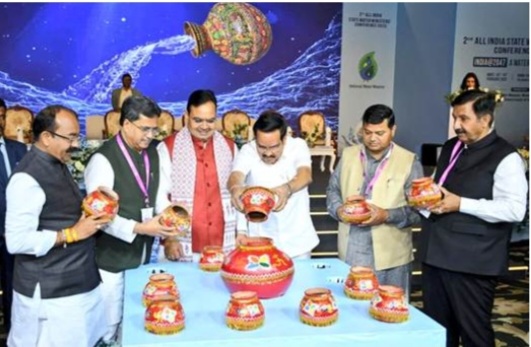Udaipur: Deputy Chief Minister of Himachal Pradesh Mukesh Agnihotri has called for a special water policy for hill states to tackle the growing crisis due to climate change.
Speaking at the 2nd State Water Ministers’ Conference in Udaipur, he highlighted that Himalayan glaciers are melting at a rate of 20-30 meters per decade, leading to unpredictable river flows and a worsening water crisis.
Himachal Seeks Special Grants for Water Security
Agnihotri stressed that despite 65% of Himachal Pradesh being covered in forests, the state gets little in return for its contribution to water conservation, environment, and ecology.
He urged the Centre to provide a special financial package suited to the difficult terrain and development limitations of hill states.
He demanded ₹2,000 crore to complete 1,000 pending drinking water schemes under the Jal Jeevan Mission.
He also proposed a special funding window for mountain states to construct anti-freeze water supply schemes in Kinnaur, Lahaul-Spiti, and Chamba, which would include insulated pipelines, heated taps, and solar-powered pumps to ensure year-round water supply in extreme cold regions.
Additionally, he sought ₹1,269.29 crore for a comprehensive snow and water conservation project and requested funds to recharge groundwater through 2,000 dry and defunct hand pumps and tube wells.
Irrigation & Urban Water Crisis
With 90% of Himachal’s population living in rural areas and 67% dependent on agriculture and horticulture, Agnihotri emphasized the need for expanding irrigation. He urged the Centre to approve pending irrigation projects under PMKSY-Har Khet Ko Pani and PMKSY & AIBP.
He also highlighted the water and sanitation crisis in suburban areas due to rapid urbanization.
Current schemes like Jal Jeevan Mission and AMRUT are not fully addressing the needs of growing towns. He called for separate funding and dedicated policies to tackle these emerging issues.
Union Minister C.R. Patil on India’s Water Security Goals
Union Jal Shakti Minister C.R. Patil inaugurated the conference, emphasizing that water security is a key pillar of Viksit Bharat @ 2047. He said that under PM Narendra Modi’s leadership, India is committed to ensuring water security for all by 2047.
He highlighted major government initiatives, including:
✅ Jal Sanchay Jan Bhagidari – A community-driven effort that has led to 1 million artificial rainwater harvesting structures across India.
✅ Jal Shakti Abhiyan – Catch the Rain – Over 1.67 crore water conservation projects completed to revive traditional water bodies.
✅ River Linking Projects – The Ken-Betwa Link (MP-UP) will irrigate 10.62 lakh hectares and provide drinking water to 62 lakh people, while the Parbati-Kalisindh-Chambal ERCP (MP-Rajasthan) will benefit 10 lakh hectares and 50 lakh people.
Patil also noted that the Swachh Bharat Mission has led to the construction of 12 crore toilets, transforming habits of 60 crore people and saving ₹8 lakh crore in healthcare costs.
National Effort for Water Conservation
The conference saw participation from 30 ministers and over 300 delegates. Chief Ministers of Odisha and Tripura, and Deputy Chief Ministers of Himachal Pradesh, Chhattisgarh, and Karnataka attended the event.
A highlight of the conference was the presentation of ‘Piku’, the National Water Mission mascot, to dignitaries.
This peacock-shaped memento was handcrafted by tribal women artists from Udaipur, promoting women’s participation in water conservation.
Himachal’s Call for Policy Change
Concluding his address, Mukesh Agnihotri reiterated Himachal Pradesh’s commitment to India@2047 – A Water Secure Nation. However, he warned that without flexible policies and increased funding, ensuring long-term water sustainability in hill states will remain a challenge.









